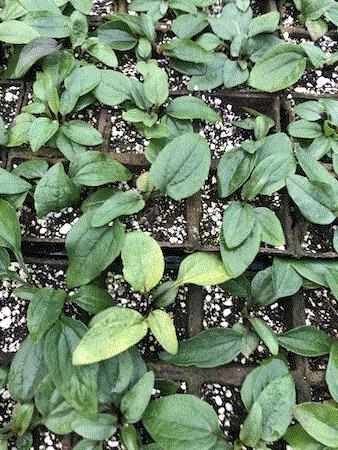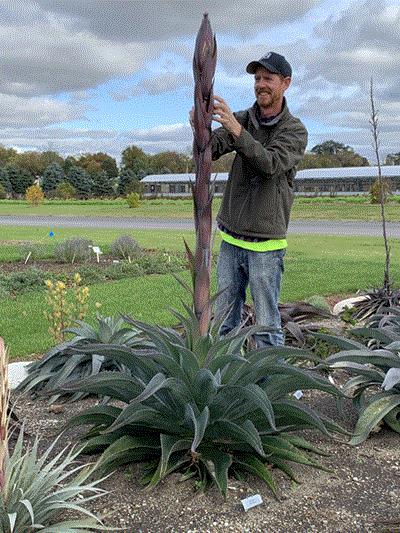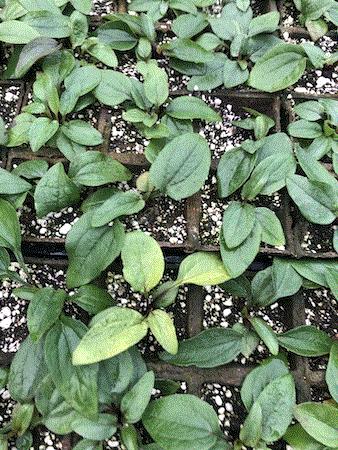What’s Happening Here?
Let’s start off the newsletter with a little diagnostic challenge. In case you’re a new subscriber (and welcome to our community) or would like a little refresher about what’s about to happen, we frequently start off the newsletter with a visual challenge where you can test your diagnostic skills and put your experience to practice while enjoying the newsletter. I may or may not provide a clue or two and ask you to determine the cause of the symptoms. At the end of the newsletter, after the opening image has had time to soak in and resonate among your brain cells, I reveal the answer and offer virtual gold stars to those who diagnosed the image correctly. Sounds like fun, doesn’t it? Well then, let’s get started.
If you’re a propagator or have purchased echinacea plugs in the past, you may have seen this:

Yes, I thought this would be familiar to many of you. However, do you know what causes the occasional yellow echinacea seedling? I’m guessing, like me, you’ve thrown out various thoughts and ideas about what was causing the sporadic yellowing, but likely never came to a definitive conclusion. Am I right?
It’s time to give this issue another shot and see if you know the real cause. Do you know "What’s Happening Here?" Take your time, enjoy the newsletter and I’ll reveal the answer in a few minutes.

New Terra Nova Intros
Each year, I eagerly await to see what fascinating new perennial introductions Terra Nova Nurseries will have and I can honestly tell you that I’m not disappointed about these recent introductions.
Sure, we’ve seen a dicentra with gold foliage before, but this one is different.
Dicentra Ruby Gold is the only gold-foliage variety that's not the product of mutation. It’s also the first gold foliage dicentra that has true-red flowers. These attributes didn’t happen by accident; they were the result of very purposeful and targeted breeding.
Ruby Gold has strong, upright stems that bear large, beautiful flowers with a touch of an unusual orange coloration. It has good vigor, a great container habit and provides a fantastic contrasting focal point in shade gardens. Ruby Gold reaches 26 in. and is cold hardy to Zone 4.
Veronica Vespers Blue is a great compact, long-blooming blue veronica. That’s right—it blooms and blooms and blooms. Vespers Blue is a great choice for containers mixed plantings and perennial borders. It's hardy to Zone 4, has great vigor and is more resistant to powdery mildew than most cultivars.

Boxwood Blight Resources
For those of you involved in the nursery or landscape side of the industry, I’m sure you’re well aware of or have personally experienced the wrath of Boxwood Blight (Colonectria pseudonaviculata, formerly known as Cylindracladium buxicola syn. C. pseudonaviculatum). This disease is one to be taken seriously and still poses a threat to the most popular broadleaf evergreen shrub—the boxwood. For this reason, I wanted to share some of the most recent best management practices (BMPs) aimed at dealing with this devastating pathogen.
The first resource I’d like to share is the Horticulture Research Institute’s Best Management Practices Boxwood Health Production and Landscape Management Version 3.0. This revised guide covers Boxwood Blight symptoms and provides the most up-to-date BMPs for boxwood health during production, as well as those that can be used in the landscape. At the end of this REFERENCE there are two "print and share" one-page BMP summaries (one for production and one for landscape).
Earlier this month, February 4 to be exact, AmericanHort, the Horticultural Research Institute and Oregon Association of Nurseries held a full-day workshop on Boxwood Blight management in Aurora, Oregon. At the workshop, experts from universities, USDA, Oregon Department of Agriculture and major boxwood producers shared their knowledge and current research results about Boxwood Blight.
Many of the presentations from the workshop are available. Click HERE to review these presentations.

Upcoming FREE Webinar
Mangave Madness: The Story Behind this Fast-Growing Succulent Hybrid
At 1:00 p.m. Eastern/12:00 p.m. Central on Tuesday, March 3, 2020, Hans Hansen, Director of New Plant Development at Walters Gardens, will be hosting a webinar on one of his most recent passions, the mangave. (Mangave is the intergeneric cross of Manfreda and Agave).

Hans has cracked the code and is taking the best traits from both genera and wowing us with several great new introductions. Come join Hans as he shares the wonders and potential Mangave has to offer the world, growers and landscapers alike. If you’re a plant connoisseur, plant breeder or plant nerd, this FREE webinar is for you.
Click HERE to register.
Upcoming Events
Looking for some great learning and networking opportunities before the spring season kicks in? Check out these upcoming trade events. Click on the name of the event for more details.
February 26, 2020—Landscape New Jersey in Secaucus, New Jersey
February 27, 2020—Nor Cal Landscape & Nursery Show in San Mateo, California
February 29, 2020—Perennial Plant Association Mid-Atlantic Regional Symposium in Baltimore, Maryland
March 1-3, 2020—AIPH Spring Meeting in Miami Beach, Florida
March 3, 2020—FLORALL in Waregem, Belgium
March 3-6, 2020—IPPS SA Annual Conference in Johannesburg, South Africa
March 4-5, 2020—ELA Conference & Eco-Marketplace in Amherst, Massachusetts
March 9-10, 2020—SAF Congressional Action Days in Washington D.C.
March 10-12, 2020—HortiFlor Expo in Harare, Zimbabwe
March 10, 2020—IGIA Pest Management Workshop in Glen Ellyn, Illinois
March 11-12, 2020—Royal FloraHolland Trade Fair in Naaldwijk, The Netherlands
March 13-22, 2020—Canada Blooms in Toronto, Ontario, Canada
March 13-14, 2020—Ithaca Native Landscape Symposium in Ithaca, New York
March 13-15, 2020—International Professional Women in Pest Management Leadership Forum in San Diego, California
March 24-26, 2020—GreenTech Americas in Santiago de Querétaro, Mexico
March 25-27, 2020—World Floral Expo in New York, New York
March 28 to April 2—California Spring Trials at assorted venues throughout California

The Answer is …
At the top of the newsletter, I shared this image of a batch of echinacea seedlings:

It reminds me of the Sesame Street song that goes something like this, “One of these things is not like the others. One of these things just doesn't belong. Can you tell which thing is not like the others by the time I finish my song?”
Were you able to figure it out? Perhaps you narrowed it down to a couple of options. I’m guessing many of you thought fertility or pH were to blame and others concluded virus was the cause of the sporadic yellowing in the echinacea seedlings. Were you right? Let’s find out.
If you answered aster yellows was the cause of the yellow seedlings, you nailed it and proudly earned the virtual gold star I offered. However, there’s no shame if you answered incorrectly. This was a tough one.
The container above was planted with multiple liners. Only one plant in the container has aster yellows.
Aster yellows, commonly referred to as witches broom, is known to occur on the flowers of echinacea (above) causing them to develop flowers with curious abnormalities. Other symptoms include stunting, chlorotic foliage and abnormal growth.
Aster yellows is a phytoplasma disease caused by a mycoplasma-like microorganism that live as parasites in the phloem of plants. Unfortunately, besides managing leafhoppers, which vector the phytoplasma, there are no effective management strategies (none once the plants are infected).
Initially, it was thought that phytoplasmas couldn’t be spread via seeds. However, there have been several crops where phytoplasma DNA has been found in seeds and/or embyros of several plant species. Recent research is now suggesting that a low percentage of seed transmission is likely.
If you see these random, chlorotic seedlings in your plugs, it’s best to rogue them out and destroy them.




Thanks for reading this edition of Perennial Pulse.
My email is ppilon@ballpublishing.com if you have any comments or suggestions.
Take care,
Paul Pilon
Editor-at-Large
Perennial Pulse
This email was received by you and 30,362 other fine subscribers!
If you're interested in advertising in Perennial Pulse, contact Kim Brown ASAP and she'll hook you up.